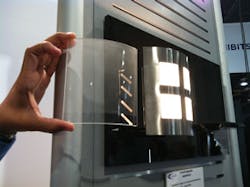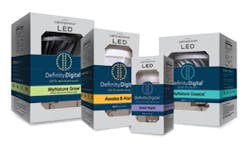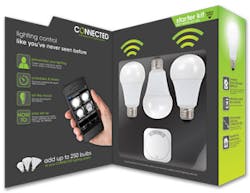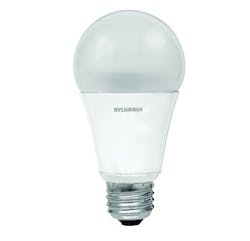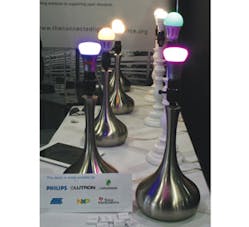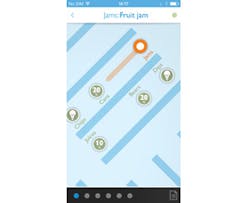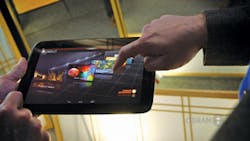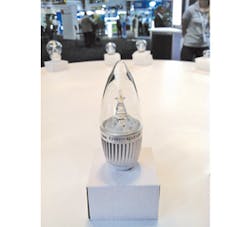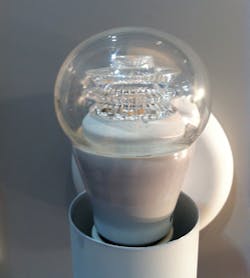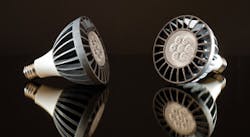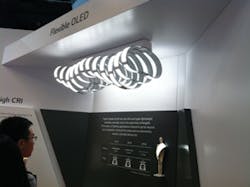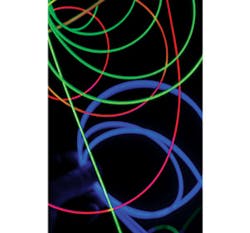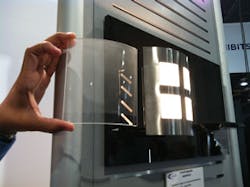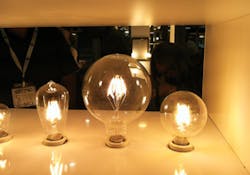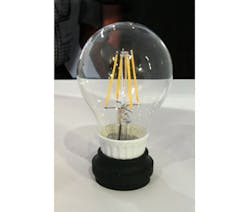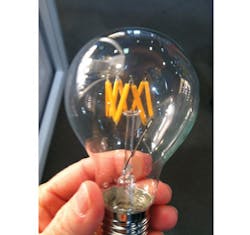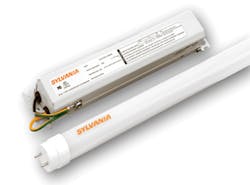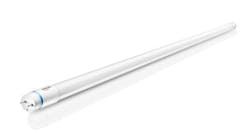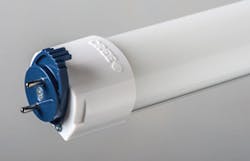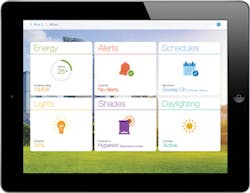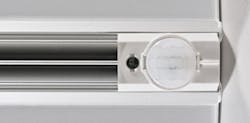The exhibit floor at LightFair International (LFI) 2014 indicated trends, some familiar and some new, in LED lighting: Mobile devices, such as smartphones and tablets, have emerged as the interface of choice for smart lighting systems; in-store communication platforms based on LED lights are emerging as an entirely new way to interact with customers; plastics were innovatively used as light guides; and perhaps signaling the true coming of age of LEDs, LED linear lights as replacements for fluorescent linear lighting were plentiful. MARGERY CONNER summarizes many interesting products that were demonstrated on the show floor.
Smart bulbs and extra features
Apple announced its HomeKit program at the start of the week, naming Philips, Cree, and Osram, among others, as approved partners. The Homekit program seeks to establish a common network protocol for home devices such as lights but also includes door locks, thermostats, and garage door openers. Other companies were demonstrating their implementation of smart bulb control, with ZigBee, Bluetooth Low-Energy (BLE), and 6LoWPan being the most common. Smart lighting is a hot spot in LED controls, because it is often seen as a stalking horse for the Internet of Things: Easily commissioned intelligent light bulbs could result in radio receivers/transceivers capable of internet connectivity positioned throughout the home.
1. LIGHTING SCIENCE GROUP'S Definity Digital light is a color-tunable family of A19 bulbs that the company says will help people sleep better by working with the body's natural circadian rhythm, producing a bluer light in the morning to help in waking up and a redder light at night to help in falling asleep.
2. PHILIPS was demonstrating its Hue, the first smartphone-controlled RGB home light bulb system, as well as the new Hue Lux and Tap (shown) additions to the Hue smart bulb line. The Hue Lux is a white-only bulb; the original Hue line is an RGB family of bulbs, controlled via a mobile device, which uses a Hue hardware gateway to communicate with a home's Wi-Fi internet modem. The Hue Tap is an on/off switch powered by the kinetic energy of being tapped to power itself.
3. TCP has its Connected by TCP family of smart bulbs for the home, which includes white LED bulbs as well as a gateway, and is controlled by a smartphone app or the included remote wireless device. The wireless network is 6LoWPAN-based. TCP also demonstrated a new smart bulb family with a BLE connection that will be available later this year. BLE doesn't require a gateway and allows for a simpler control and commissioning approach. Integral to each bulb are multiple timers, which the homeowner can program for on/off times, controlling the lights when the homeowner — and the smartphone — are not present.
4. OSRAM will enter the smart bulb business this fall with its Lightify product family, which supports multiple network protocols: ZigBee, Wi-Fi, and DALI (digital addressable lighting interface). Osram also introduced its new three-way bulb: The omnidirectional Sylvania Ultra 3-Way A-Line LED lamp is equivalent to a three-way incandescent 25/40/75W lamp but uses only 4W, 7W, or 14W and delivers 300, 500, or 1100 lm. Three-way bulbs seemed to be experiencing a small flurry of introductions: Cree also announced a new three-way bulb on Wednesday of the show. And TCP had a three-way lamp it was demonstrating, which will not be in production until the end of the summer.
5. THE CONNECTED LIGHTING ALLIANCE was started to promote an open protocol for ZigBee-based indoor networks for lighting. The alliance was demonstrating the control of the Philips Hue bulb and the Leedarson smart bulb, interchangeably controlled by a variety of devices.
Indoor location services
Beyond simply lighting stores, lighting companies are trying to get inside the consumer's head with in-store communications and location services. The offerings are mostly based on the use of light pulses from in-store LED lights to communicate with the customers’ cell phone cameras. Customers must have an app enabled on their phone for the communication to take place. In addition to premiums such as promotional coupons, the systems can help guide customers to products within the store in a more fine-grained approach than with a system such as GPS, especially given that GPS doesn’t work reliably indoors. (For more information, see our full story, "Major LED lighting vendors demo retail location services.")
6. ACUITY is partnering with chip-maker Qualcomm Technologies, emphasizing that no additional hardware is needed other than the regular overhead LED lighting fixtures for its in-store communication approach. Based on Qualcomm's Lumicast technology, Acuity says its smart LED lighting will allow retailers to engage with customers on mobile devices based on their location in the store (not shown).
7. PHILIPS LIGHTING designed its own in-store communication system that was first demonstrated back in February at the EuroShop trade fair in Germany. The Philips implementation relies on Visible Light Communications (VLC) alone.
8. GENERAL ELECTRIC announced its partnership with ByteLight. ByteLight's technology combines VLC, BLE, and inertial device sensors to enable LED lights as indoor location waypoints. The LED lights can communicate via pulsed light to a mobile device with a camera and/or BLE, assuming the owner of the device opts in.
9. OSRAM introduced Debut, which uses retail store changing-room lighting to entice consumers into physical storefronts. Debut combines natural, location-specific lighting along with video backdrops appropriate to places where the clothing might be worn, such as trying on swimsuits for the beach, or a cocktail dress for a restaurant. The lighting matches the virtual setting, making for bright Waikiki beach sunlight for the beach setting, or flickering warm candlelight for a restaurant (control app shown).
Plastics and planar fixtures
From candelabra bulbs to special lighting effects to edge-lit fixtures, plastics are finding new uses when paired with LEDs. They can even give OLEDs a run for their money in curved fixtures. And edge lighting technology can result in extremely thin luminaire designs. Still, impressive OLED products were also on display at the fair.
10. LIGHT EMISSION TECHNOLOGY's candelabra-base lamp uses a plastic light guide to shape the LED light so it mimics the flame-like appearance of an incandescent candelabra lamp.
11. OSRAM SYLVANIA's Ultra omnidirectional clear bulb also relies on a light guide to shape the LED light by bringing the light up past the base of the bulb so the light is omnidirectional. The result is much more pleasing than the more common spotlight effect of a sno-cone bulb.
12. BAYER MATERIALSCIENCE'S Makrolon TC 8030 polycarbonate plastic is a thermally conductive polycarbonate grade that has similar thermal properties compared to aluminum, but it can reduce costs by eliminating assembly steps, thereby improving production efficiency and reducing capital investments.
13. LG CHEM had an impressive display of OLEDs that were not only bendable but bending in real time, as was seen in this kinetic light sculpture. The potential applications go beyond what can easily be accomplished with LED sources. Moreover, LG said at LightFair that it was moving to slash OLED panel prices.
14. CORNING INCORPORATED demonstrated Fibrance, illuminated with laser diodes. You've probably seen electro-luminescent (EL) wire used as trim for clothing, automobiles, and bikes; it looks great at night and shapes easily. However, EL wire has a relatively limited life. Fibrance is an optical fiber that, when lit by a laser diode, mimics the versatility and light intensity of EL wire at a much longer lifetime, limited only by the laser diode's life. It's available in fixed colors or with a variable RGB laser diode component about the size of a AAA battery.
15. GLOBAL LIGHTING TECHNOLOGIES showed a less-expensive approach to a bendable light-emitting surface through edge-lit plastics. The plastic also served as a light diffuser, eliminating the pixelated effect of multiple LED point sources of light.
LED incandescent-like filaments
Several companies showed a novel use of LED components that seemed to hang inside the bulb, similar to an old-style filament incandescent lamp. Such designs could virtually pass for a legacy bulb while offering the energy savings of LED sources.
16. ARCHIPELAGO LIGHTING's Thread candelabra lamp used a filament-style LED package that mimics incandescent, large-filament retro-style lamps. Archipelago also showed several other lamp styles in the Thread family.
17. LIGHTING SCIENCE GROUP had the retro-style filament lamps in A19 bulbs as well as candelabra bases.
18. Z-LIGHT had an LED lamp similar to the ones exhibited by Archipelago Lighting, with the filaments arranged in a zigzag pattern.
Linear LED fluorescent replacement lamps
LEDs are proving to be viable alternatives to T8 and T12 tube lamps, the last stronghold of fluorescent lighting. While early LED-based tubes could not match fluorescent lamps in terms of light output or distribution, improvements in both LED components and tube design are making the technology competitive. Moreover, many of the latest products work with existing fluorescent ballasts as we discuss in the feature article "How do plug-and-play T8s stack up against ballast-bypass LED lamps?."
19. OSRAM SYLVANIA's Ultra HE T8 LED lamp has a dedicated external driver requiring non-shunted G13 medium bi-pin lamp holders. Delivering up to 1150 lm at 10W for 2-ft lamps and 2450 lm for 4-ft lamps at 19W, the T8 LED lamps are available in 3000K, 3500K, 4100K, and 5000K color temperatures with a color rendering index (CRI) of 80.
20. PHILIPS' InstantFit is a replacement lamp compatible with instant start ballasts, which make up 80% of the installed base of fluorescent tube ballasts. It produces 1500 lm from 14.5W, for an efficacy of 103 lm/W. Its CRI is listed as 83, and it comes in a range of color temperatures from 3000K to 5000K. The InstantFit operates at temperatures as low as -22°F (-30°C).
21. CREE's T8 LED linear replacement lamp produces 2100 lm while using 21 W, and the company says it works with 90% of all electronic fluorescent T8 ballasts in use. The lamp has a CRI of 90, is dimmable, and is available in 3500K and 4000K versions.
Mobile devices as lighting controllers
Intelligent lighting control, combining LED lights, sensors, and control software, is essential to achieve energy savings in commercial and municipal lighting. And users of lighting control systems — both at the residential and commercial level — have spoken loud and clear: They want to interface with lighting via their ever-present handheld devices. While Android devices are usually listed as being compatible, the vast majority of demos used Apple's devices.
22. LUTRON's Quantum Total Light Management System adds the ability to access its Quantum Vue building management software from any mobile device, allowing facility managers to optimize lighting energy performance while reducing maintenance and operating costs. Quantum Vue software ties all building lighting and shade controls together under one system interface via a mobile device, smartphone, and computer.
23. CREE's SmartCast technology is a self-programming wireless lighting control system. Cree bucks the trend toward compatibility with mobile devices such as a smartphone or tablet by relying on a custom remote device. Since the system itself is intelligent, the actual remote control device can be simpler (and cheaper) than a smartphone.
MARGERY CONNER is the owner of the Designing with LEDs website (www.designingwithLEDs.com) and a veteran technology journalist.
